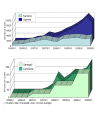Implementing services for Early Infant Diagnosis (EID) of HIV: a comparative descriptive analysis of national programs in four countries
- PMID: 21749730
- PMCID: PMC3161890
- DOI: 10.1186/1471-2458-11-553
Implementing services for Early Infant Diagnosis (EID) of HIV: a comparative descriptive analysis of national programs in four countries
Abstract
Background: There is a significant increase in survival for HIV-infected children who have early access to diagnosis and treatment. The goal of this multi-country review was to examine when and where HIV-exposed infants and children are being diagnosed, and whether the EID service is being maximally utilized to improve health outcomes for HIV-exposed children.
Methods: In four countries across Africa and Asia existing documents and data were reviewed and key informant interviews were conducted. EID testing data was gathered from the central testing laboratories and was then complemented by health facility level data extraction which took place using a standardized and validated questionnaire
Results: In the four countries reviewed from 2006 to 2009 EID sample volumes rose dramatically to an average of >100 samples per quarter in Cambodia and Senegal, >7,000 samples per quarter in Uganda, and >2,000 samples per quarter in Namibia. Geographic coverage of sites also rapidly expanded to 525 sites in Uganda, 205 in Namibia, 48 in Senegal, and 26 in Cambodia in 2009. However, only a small proportion of testing was done at lower-level health facilities: in Uganda Health Center IIs and IIIs comprised 47% of the EID collection sites, but only 11% of the total tests, and in Namibia 15% of EID sites collected >93% of all samples. In all countries except for Namibia, more than 50% of the EID testing was done after 2 months of age. Few sites had robust referral mechanisms between EID and ART. In a sub-sample of children, we noted significant attrition of infants along the continuum of care post testing. Only 22% (Senegal), 37% (Uganda), and 38% (Cambodia) of infants testing positive by PCR were subsequently initiated onto treatment. In Namibia, which had almost universal EID coverage, more than 70% of PCR-positive infants initiated ART in 2008.
Conclusions: While EID testing has expanded dramatically, a large proportion of PCR- positive infants are initiated on treatment. As EID services continue to scale-up, more programmatic attention and support is needed to retain HIV-exposed infants in care and ensure that those testing positive initiate treatment in a timely manner. Namibia's experience demonstrates that it is feasible for a rural, low-income country to achieve high national coverage of infant testing and treatment.
Figures






References
-
- UNAIDS. 2010 Report on the Global AIDS epidemic. Geneva; 2010. Chapter 2: Epidemic Update.http://www.unaids.org/en/media/unaids/contentassets/documents/unaidspubl... Available: Accessed April 15, 2011.
-
- WHO, UNICEF, UNAIDS. Towards Universal Access: Scaling up Priority HIV/AIDS Interventions in the Health Sector: Progress Report 2010. Geneva; 2010. Chapter 5: Scaling up HIV Services for Women and Children.http://www.who.int/hiv/pub/2010progressreport/ch5_en.pdf Available: Accessed 4 October2010.
-
- WHO. WHO recommendations on the diagnosis of HIV infection in infants and children. Geneva; 2010. http://whqlibdoc.who.int/publications/2010/9789241599085_eng.pdf Available: Accessed 15 April 2011. - PubMed
Publication types
MeSH terms
LinkOut - more resources
Full Text Sources
Molecular Biology Databases
Research Materials

